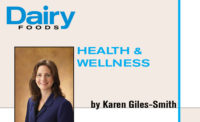Fortifying with vitamins & minerals

We’ve heard it before, but it bears repeating: Most consumers aren’t getting enough dietary potassium, fiber, calcium and vitamin D. The Dietary Guidelines for Americans 2010 states that fortification of foods can help bridge this nutrient gap. “Dietary supplements or fortification of certain foods may be advantageous in specific situations to increase intake of a specific vitamin or mineral,” according to the report.
When fortifying foods with additional vitamins and minerals, dairy products have a leg up on the competition. Dairy products are already nutrient-rich, so it makes sense to consider adding more of the nutrients consumers need; whereas it makes less sense to add nutrients to nutrient-poor foods. That said, there is much for dairy processors to contend with when formulating products and when communicating the benefits of fortification to consumers.
“Since dairy products have a standard of identity, those best suited for additional fortification from a technical perspective are not necessarily the same from a regulatory perspective,” noted Diane Hnat, senior technical marketing manager, DSM Nutritional Products, Parsippany, N.J. “There may be some challenges either way but, by and large, nearly all dairy products present themselves as excellent vehicles for nutritional fortification in some way.”
And, in fact, fluid and nondairy milks, yogurt and yogurt drinks, and processed cheese are the products on the market today that have the most fortification, said Todd Sitkowski, DSM’s senior marketing manager.
However, these products have met with variable market success and consumption of functional foods, including fortified foods, is stagnant. Why? The answer may lie within the 2013 Functional Foods Consumer Survey recently released by the International Food Information Council.
Consumers’ views
IFIC’s survey investigated consumers’ perceptions of functional foods, defined as foods that have health benefits beyond basic nutrition. Results revealed that:
- While the majority of consumers (53%) believe that fortified foods are worthwhile — and they’re more likely to believe so if they’re very concerned about not getting enough nutrients/healthful food components — 51% prefer food with “naturally occurring benefits” over fortified foods, 46% don’t have a preference, and a mere 3% prefer fortified foods.
- The major barriers to more frequent consumption of “health promoting foods and food components” are lack of knowledge about functional food’s health benefits/health claims, including which foods to purchase and how much to consume (64%), cost (55%), skepticism of food manufacturer’s motives for adding health components to so many products (34%), preference for the purity of basic foods with nothing added (37%), taste (31%), and confusion over conflicting information (27%).
- Although the majority of consumers believe they get enough vitamin D (68%) and potassium (61%), according to NHANES data, only 32% get enough vitamin D and less than 3% get enough potassium.
Sarah Romotsky, a registered dietician and IFIC’s associate director of health and wellness, said she believes that functional foods, including fortified foods, can be a resource to help consumers meet their nutrient needs. “We see that consumers recognize the value of fortified foods and are open to different types of foods to provide the nutrients they need,” she said. “There is room [for education about functional/fortified foods] to grow.”
Communicating with consumers
To that end, consumers’ misperceptions about nutrient intake need to be addressed. “Consumers should understand the potential health benefits fortified foods can offer,” Romotsky explained. “There is a need to increase communication about why vitamins, minerals and other components are added to foods and why they are important to the diet. More communication will lead to more awareness which may result in increased acceptance of fortified foods.”
Several situations illustrate the value of fortifying dairy products with additional vitamins and minerals. Here’s a sampling:
- Nestle has commissioned research investigating the health outcomes in children (6 months to 5 years of age) in developing countries who consume fortified milk and cereal products. Although health outcomes are not clear, results suggest that, when compared to children who consume nonfortified food, consumption of iron-fortified products improve children’s hemoglobin levels and multi-micronutrient-fortified milk and cereals do so to an even greater extent.
- A new study published in Nutrients examined the food sources of energy and nutrients for U.S. children aged 2 to 18 years and found that milk was the highest ranked dietary source of vitamin D, providing 60.4% of the vitamin D in children’s diets. The next-highest-ranked sources were milk drinks and ready-to-eat cereals, at about 8% each.
- In September, the National Osteoporosis Foundation released new data indicating that the number of adults at risk for developing osteoporosis (48 million) is at an all-time high. One of the major strategies of osteoporosis prevention is consuming adequate calcium and vitamin D via a food-first approach. In some populations, it’s possible that fortification with additional calcium and vitamin D may be warranted.
“Yogurts, milks and cheeses are staples in the American diet and there’s room to expand the healthfulness and remind consumers of the nutrition in these products when we call out particular nutrients,” said Hnat. “With due diligence in the product development and market research phases, a company can successfully deliver delicious, nutritious dairy products with a ‘competitive edge.’”
Karen Giles-Smith, a registered dietitian in Michigan, is Dairy Foods’ health and wellness editor. She blogs at www.thewellnesswriter.com/blog.
Which vitamins and minerals work best for dairy fortification
When adding oil-soluble vitamins (A, D and E) to dairy products, a major consideration is that the potency of the straight oily vitamin, as manufactured, is very high. Vitamin A Palmitate needs to be diluted with other oils/emulsifiers or encapsulated to a dry form so the dairy product, such as milk, delivers typically 500 IUs per 8-ounce serving.
When calculating and adding the amount of a nutrient, be sure to account for processing, packaging and shelf-life of the product. In the case of minerals, adding overage or extra is generally not required but for vitamins and other nutraceuticals, it can make the difference between meeting the label claim or not.
Source: DSM
Definitions, facts & opinions
There are several definitions of functional foods; however, the term has no legal meaning in the United States. Here are statements from three organizations.
- “Whole foods along with fortified, enriched or enhanced foods that have a potentially beneficial effect on health when consumed as part of a varied diet on a regular basis at effective levels based on significant standards of evidence.” Position of the Academy of Nutrition and Dietetics: Functional Foods, 2013
- Fortification is the voluntary addition of nutrients at levels beyond those naturally occurring in the food. Globally, the decision to fortify products is up to individual food manufacturers. Fifty countries including the United States, Canada, and Australia require mandatory fortification of certain staple foods with specific nutrients to improve public health and restrict the fortification of foods with certain nutrients such as vitamin D. The indiscriminate addition of nutrients to foods and the fortification of fresh produce, meat, poultry, or fish products is not allowed by the U.S. government. “Food Fortification in Today’s World,” IFIC, January 2010
- “In general, functional foods have the potential to minimize health care costs while improving health and wellness, and giving consumers greater control over their health by providing a convenient form of health-enhancing ingredients.” Position of the Academy of Nutrition and Dietetics: Functional Foods, 2013
Looking for a reprint of this article?
From high-res PDFs to custom plaques, order your copy today!






